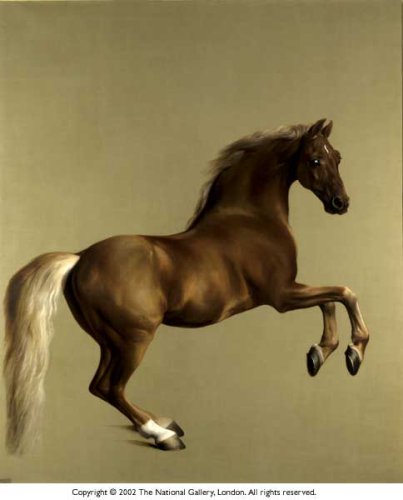Stubbs and the Horse
dal 28/6/2005 al 25/9/2005
Segnalato da
28/6/2005
Stubbs and the Horse
The National Gallery, London
George Stubbs was a greatest painter of horses. Assembling some of his finest paintings and most beautiful anatomical drawings, the exhibition explores the social, cultural and intellectual environment in which they were produced, providing a fascinating insight into the importance of the horse in 18th-century British culture.

George Stubbs
Supported by Juddmonte Farms
George Stubbs was not only the greatest of all British horse painters, but arguably the greatest painter of horses in the history of European art. 'Stubbs and the Horse' is the first exhibition to focus solely on this theme in his work.
Assembling some of his finest paintings and most beautiful anatomical drawings, the exhibition explores the social, cultural and intellectual environment in which they were produced, providing a fascinating insight into the importance of the horse in 18th-century British culture. It also reunites paintings commissioned by Stubbs's highly cultivated patrons, such as the 2nd Marquess of Rockingham, for whom the National Gallery's great painting 'Whistlejacket' was made.
The exhibition will include Stubbs's 'sublime' paintings of horses attacked by lions and his classically inspired, frieze-like studies of mares and foals at stud farms, as well as riding portraits, conversation-pieces and scenes from the stableyard and racecourse.
'Stubbs and the Horse' is organised by the Kimbell Art Museum, Fort Worth, in association with the Walters Art Museum, Baltimore, and the National Gallery, London.
STUBBS, George
1724 - 1806
British
George Stubbs was classified in his lifetime as a sporting painter, and as such was looked down on by the art establishment. He is best remembered for his paintings of horses and his conversation pieces. He studied anatomy, and his pictures of horses are among the most accurate ever painted, but his work is lyrical and transcends naturalism.
Stubbs was born in Liverpool, the son of a leather worker, and he spent his early career in the north, painting portraits and developing his interest in anatomy. In the later 1740s he lived in York and supplied the illustrations for a treatise on midwifery (published 1751). Following a brief visit to Rome in 1754 he settled in Lincolnshire, where he researched his major publication, 'The Anatomy of the Horse' (1766). In about 1758 he moved to London, which remained his base.
Early clients for his sporting and racing paintings included many of the noblemen who founded the Jockey Club. Like Gainsborough, he later painted scenes of peasant life, as well as studies of wild and exotic animals. He also became known as a printmaker and for his paintings in enamel on Wedgwood earthenware plaques.
Image: George Stubbs, 'Whistlejacket', about 1762. London, The National Gallery.
The National Gallery
Trafalgar Square
London WC2N 5DN
Sainsbury Wing
10am - 6pm daily
(last admissions 5.15pm)
10am - 9pm Wednesdays
(last admissions 8.15pm)



